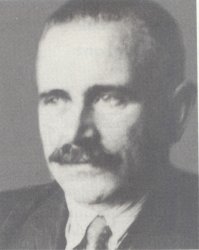
Colonel Doctor Stefan Tarnawski pseudonym "Tarło"
Medical services during the Warsaw Uprising
Old Town
Within the first days of the uprising, the situation in the Old Town was relatively quiet. Dense buildings in the area and the lack of significant German posts meant that insurgents could easily conquer the area and prepare for further fights. The situation changed when Germans conquered Ochota and Wola. Since then they started systematically attack the Old Town. And it caused the Old Town was a stronghold completely sealed off by the enemy.
The defensive lines were marked out from the east by the PWPW building and the Vistula embankment, from the south by the Castle Square, Teatralny Square, from the west Bielańska Street, ghetto ruins, from the north Stawki, Tram Depot At Muranów and Konwiktorska Street.
The Old Town was the operational area of the "North" Group commanded by Colonel Karol Ziemski pseudonym "Wachnowski". Since 11th of August, the Old Town units were reinforced by the forces of "Radosław" Group retreated from Wola. Heavy fights started by then. Germans bombarded the Old Town using their artillery, planes, an armoured train, mine launchers, goliaths and even a gunboat sailing on the Vistula.
In the second week of the uprising, there were two unsuccessful attempts to connect with Żoliborz, and by the end of August, there was another unsuccessful attempt to break through to Downtown. The area was under the constant attack and as a result of it, the area in possession of insurgents drastically shrank. Several dozens of civilians and insurgents were crowded in small space. In such a situation, the Headquarters decided to evacuate soldiers and the lightly wounded to Downtown and Żoliborz using sewers as the evacuation route. The last units left the Old Town in the afternoon. In total, there were about 3 600 soldiers, including the wounded, who left the Old Town and headed mainly Downtown. Civilians were not evacuated and stayed in the area, and hospitals were crowded with the heavily wounded and injured.
There were two hospitals in the Old Town at the moment of the uprising outburst and those were: the Maltese Hospital at 42 Senatorska Street and Hospital of Jan Boży at Bonifaterska Street corner of Konwiktorska Street. The Chief of the medical services of the "North" Group was Colonel Doctor Stefan Tarnawski pseudonym "Tarło".

Colonel Doctor Stefan Tarnawski pseudonym "Tarło"
The Maltese Hospital happened to be located in the particularly dangerous area, between German posts in the Saxon Garden, the Wermacht Headquarters on Teatralny Square, and the Old Town held by insurgents. From the moment of the uprising outburst, the hospital admitted wounded insurgents as well as wounded Germans. On 4th of August the Polish Home Army Medical Command managed to get to the hospital and the next day, Dr Leon Strehl pseudonym "Feliks" became the commander of the Malta Hospital.
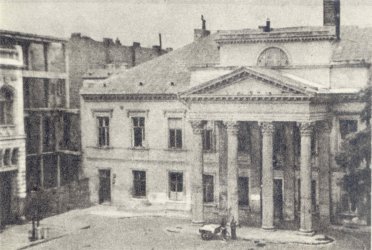 |
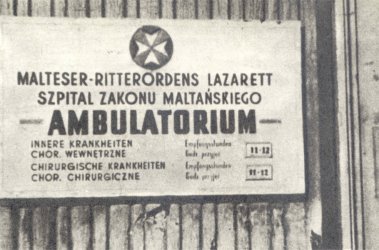 |
Maltese Hospital
From 4th of August the amount of wounded from Wola admitted to the hospital drastically increased. Part of the arriving wounded was transferred to other hospitals inside of the Old Town located at 7 Barokowa Street, 7 Długa, 23 and 24 Miodowa Street. And in the building at 36 Senatorska Street, there was created additional hospital ward with 60 beds for lightly wounded.
On 7th of August the hospital was shot at by a German tank located in Senatorska Street. Germans displaced the residents of buildings at 36 and 38 Senatorska Street as well as the wounded and nurses. Once the German soldiers entered the hospital they asked for wounded Germans. And they were taken to them. Good treatment they received from the hospital personnel caused that the hospital avoided the massacre. The displaced from the adjoining buildings were rushed towards Pruszków, and the wounded Germans were taken away at night by medical vehicles with support of the armoured cars.
On 14th of August, the hospital premises were entered by an SS company of the Dirlewanger Brigade. All the wounded and the hospital personnel were thrown out. Because the Maltese Hospital was the branch of the Ujazdowski Hospital, Dr Strahl made a decision to evacuate the wounded towards that hospital. He talked into it the commander of German unit. The German commander assigned an escort and a long column surrounded by hospital personnel wearing white aprons marched through full-of-Germans Saxon Garden. German attitude was probably influenced by fluent German spoken by Colonel Strahl as well as confidence when telling the German commander that he was ordered to transfer the hospital to the Ujazdowski Hospital. From that time on he was called by his closest co-workers: "Moses".
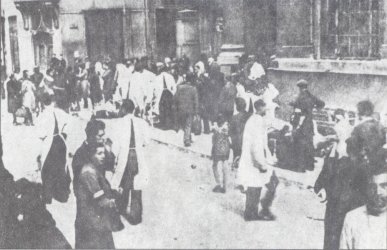 |
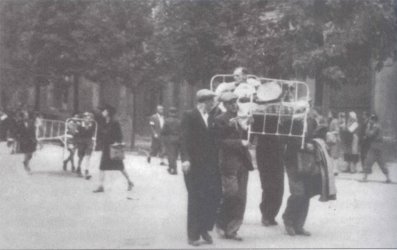 |
Evacuation of the Maltese Hospital
The column luckily got to the Polish post at Królewska Street and then was directed to the PKO building at Jasna Street. After a couple of days the "Malta" personnel was transferred to a newly open hospital at 11 Zgoda Street.
There were left about 30 wounded at the Maltese Hospital who were not evacuated as there was no enough people to carry them. Next day Germans ordered an evacuation. Dr Dreyza who looked after the left wounded, collected several dozens of civilians, what probably saved their lives, and under the flag of Red Cross moved with part of the wounded towards Wola. The column was accompanied by a German soldier who on several occasions saved the column members from hostile attempts of German units which the column was passing by along the way. They luckily got to the Wola Hospital at Płocka Street. The hospital building after the massacre which took place earlier, was empty at the time and the column took one of the hospital wards. Within the next few days, the same evacuation action was repeated and all the wounded from Senatorska Street were brought to safety.
The evacuation of the Maltese Hospital was an unprecedented event during the Uprising. The first evacuation was not the last, the next relocation was from Zgoda Street to 17 Śniadeckich Street where the hospital was operational until the Uprising capitulation, and afterwards the hospital along with equipment for 120 patients was evacuated to Piastów.
The Hospital of Jan Boży belonged to the former Psychiatric Clinic of the Warsaw University. It had an educated and devoted personnel and their surgeons were considered to be very good. The hospital before uprising was well equipped in medicines and food, however the amount of wounded coming into the hospital during the uprising caused the lack of hospital beds. The mentally ill patients were gradually moved to smaller rooms, the lack of beds was noticeable. Wounded had to be laid on pallets, and sharing the place with the mentally ill surely did not help with recovery. Lieutenant Colonel Stanisław Tarnawski pseudonym "Tarło" who was ordered by Colonel Strahl to organise the medical services at the Old Town, got to the hospital on 7th of August and stayed there for a couple of days.
After the 10th of August, the hospital building was situated near the front line, and was under fire. The wounded were evacuated deeper into the Old Town. However, yet on 12th of August, during the fights at Stawki, wounded soldiers were brought to the hospital. On the ground floor, near the operating and treatment rooms, heavily wounded laid on stretchers waiting for their turn for treatment.
Evacuation was carried out in two steps on 15th and 20th August, and 300 patients were evacuated to a newly organised hospital in the building of Ministry of Justice at 7 Długa Street (Raczyńscy Palace).
Heavy fights took place in the building of the Hospital of Jan Boży and lasted until the end of August. Soldiers of the "Radosław" Group heroically fought against the-outnumbering-them enemy forces.
During the uprising, the Old Town during the uprising had organised a chain of field hospitals:
- Central Surgical Insurgency Hospital #1 at 7 Długa Street, 600 beds;
- Surgical Hospital #2 at 23 Miodowa Street, about 300 beds;
- Field Hospital #3 at 24 Miodowa Street, about 200 beds;
- The "Gustaw" battalion Field Hospital #4, basements of the Monastery of Sisters of the Blessed Sacrament at New Town Market,
- The "Gozdawa" Group Field Hospital #5 at Przyrynek 4, then relocated to 15 Długa Street, about 200 beds, bombarded on 20th of August, majority of the wounded and personnel died as a result of the bombardment;
- Field Hospital "Pod Krzywą Latarnią" at 25 Podwale Street, about 200 beds;
- Field Hospital "Pod Czarnym Łabędziem", branch of the hospital #1 at 46 Podwale Street, about 30 beds;
- Hospital - branch of the hospital #1, basements of the Church of St. Jacek at 10 Freta Street, formerly dressing station of the "Dzik" battalion, bombarded twice on 26th of August and 1st of September;
- The "Róg" Group Field Hospital, located at Szlenkier Net Factory at Świętojerska Street corner of Ciasna Street, as a result of the bombardment, the hospital relocated to near market hall at 3 / 4 Świętojerska Street;
- Hospital at Daniłowiczowska Street (former prison), also medical point for civilians;
- Isolation Hospital at Hipoteczna Street;
- Hospital at Brzozowa Street;
- Hospital at the PWPW, located in so call Presidential Shelter;
- Hospital at Krzywe Koło Street;
- Hospital at Fukier Wine Bar at Old Town Market;
- German Reconvalescent Hospital taken over by the "Parasol" battalion at Barokowa Street, then relocated to 7 Długa Street, 23 and 24 Miodowa Street;
Apart from field hospitals, the Old Town had also organised several dressing stations:
- "Arsenal" Dressing Station at Długa Street;
- "Hala Mirowska" Dressing Station at Chłodna Street;
- "Muranów" Dressing Station;
- The "Bończa" unit Dressing Station at 19 Podwale Street;
- The "Bończa" unit designated Dressing Station in the Cathedral sacristy at Świętojerska Street;
- The "Parasol" battalion' Dressing Station at Krasińscy Palace (first at the ground floor, then in the basement);
- Dressing Station in the Municipal Cinema basements at 8 Hipoteczna Street;
- Dressing Station at 27 Długa Street;
- Dressing Station at 20 Długa Street;
- Dressing Station at Brzozowa Street;
- Dressing Station for the NSZ soldiers at Gogolewski at 16 Długa Street;
- Dressing Station for the AL soldiers at 40 Old Town Market, relocated to 5 Freta Street, then 4 / 6 Świętojerska Street.
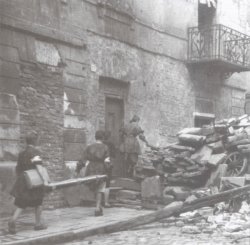
Medical patrol walking over the barricade at Piekarska Street corner of Rycerska Street
The Central Surgical Insurgency Hospital #1 started on 12th of August at Raczyńscy Palace, the pre-WWII Ministry of Justice building, at 7 Długa Street. The necessity to establish a large field hospital resulted from the fact that the Maltese Hospital was captured by Germans and evacuated, and the Hospital of Jan Boży from 10th of August happened to be on the front line. The wounded from the both hospitals were evacuated deeper into the Old Town and relocated to 7 Długa Street.
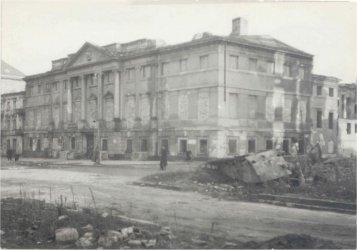
Ruins of hospital at 7 Długa Street (photo taken after war)
Hospital at 7 Długa Street apart from being a hospital was also a medical depot supplying other hospitals and dressing stations of combat units. Part of the equipment and medicines used by the hospital was evacuated from the Hospital of Jan Boży, and the rest was commandeered from local pharmacies, food came from warehouses located in Old Town, beds and bed clothes were donated by civilians. After 20 of August, medical supplies were brought through sewers from Downtown.
Originally, the hospital at 7 Długa Street was the "Wigry" battalion hospital and was managed by Dr Izabela Niedżwiecka pseudonym "Bela". On 13 of August, Dr Adolf Falkowski, former commander of the Hospital of Jan Boży, became the new hospital commander. The surgical personnel also came from the Hospital of Jan Boży. Nurses and combat medics working there very experienced and came from various combat units. And that fact had significant meaning for the wounded as they felt better being looked after by girls-known-to-them.
More and more wounded were carried over to the hospital. The amount of wounded coming into hospital increased drastically after an explosion of a "tank-trap" on 13 of August at Kiliński Street and as a result of the explosion the Chief Medical Officer of the "North" Group, Dr Tarnawski, ordered to commandeer all basements, ground and first floor flats in Podwale Street up to Freta Street, for treatment of lightly wounded and convalescents.
The wounded in the hospital laid down everywhere, on beds, next to beds, on pallets in the corridors, stretchers and blankets. Non-stop surgical operations. By the end of August, the amount of operations carried out in the hospital reached the figure of 1000. There were carried out standard minor and dangerous surgeries: laparotomies, bowel resections, skull trepanations, limb amputations and chest surgeries. Walwanol was used to disinfect wounds and ether was used as anaesthesia for surgeries. There were carried out blood transfusions and even blood surrogate transfusions. The hospital had its own source of illumination in the form of dynamo, however candles were also in use. As the time went by, the lack of beds and bed clothes was noticeable, and the shortage of water constantly increased. The hospital was permanently under artillery fire and aerial bombardment. On 19 of August, the second floor of the building was destroyed and the wounded were relocated to the basements.
After unsuccessful attempt to break through to Downtown which took place by the end of August, the command of the "North" Group decided to save the wounded and evacuate them through sewers to Downtown, while the lightly wounded, majority of the medical personnel and combat units were to evacuate to Żoliborz using the underground sewers. The last soldiers entered the sewers at night on 1st and 2nd of September. In the ruins of the Old Town left several dozens of civilians and many severely wounded insurgents and civilians whom were accompanied by certain medical personnel. Combat medics were bringing the wounded from various dressing stations and small hospitals to the hospital at 7 Długa Street and believed that the wounded were safe there.
On 2nd of September, the first German units entered the Old Town from the direction of the Castle Square. They shortly got to the hospital at 7 Długa Street. Germans ordered the hospital personnel and the wounded and ill who could walk to come out. The severely wounded meant to remain at their quarters. Those who came out, formed a column and which was rushed through Podwale Street towards the Castle Square. From the moment the Germans soldiers entered the hospital they started killing those who they considered to be bandits and insurgents. In the meantime, the severely wounded left in the hospital building were massacred. The laying wounded were shot from the automatic weapon and killed by thrown-in grenades. Some of the wounded burned alive. Corpses of the killed were later poured with gasoline and lit up. Human remains of the killed left untouched at the place until January 1945. According to the later findings, Germans murdered about 200 people at the hospital at 7 Długa Street.
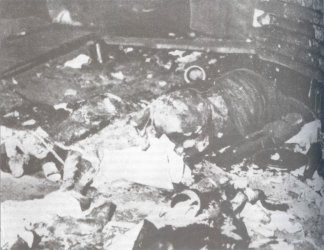 |
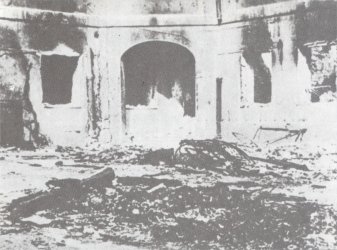 |
Burned corpses of the wounded insurgents murdered in the hospital rooms and the hospital courtyard at 7 Długa Street
Similar situation took place in other hospitals: "Pod Krzywą Latarnią", "Pod Czarnym Łabędziem" and many other places where the wounded insurgents and civilians found shelter. It is difficult to establish how many wounded died of bullets and grenades and how many died as martyrs in flames. Only few of them managed to hide from murderers. Those were saved on 5th of September by the Polish Red Cross teams which were searching the area and looking for survivors in the Stara Street area, at the back of the Church of St. Jacek, and some were found and saved already after the uprising capitulation.
Maciej Janaszek-Seydlitz Copyright © 2018 Maciej Janaszek-Seydlitz. All rights reserved.
The displaced Old Town residents were walked through the ruins and rubble to Wola. At the Church of St. Stanisław in Wola took place an initial selection of the wounded after which some of the survivors were rushed to Ursus and Pruszków, and the rest of the wounded were directed to the Wola Hospital. Many of those died of exhaustion along the way, and many were murdered by Germans.
Another Warsaw district paid a horrible price and experienced unprecedented cruelty of the German Herrenvolk representatives.
translated by: Janusz Kocerba